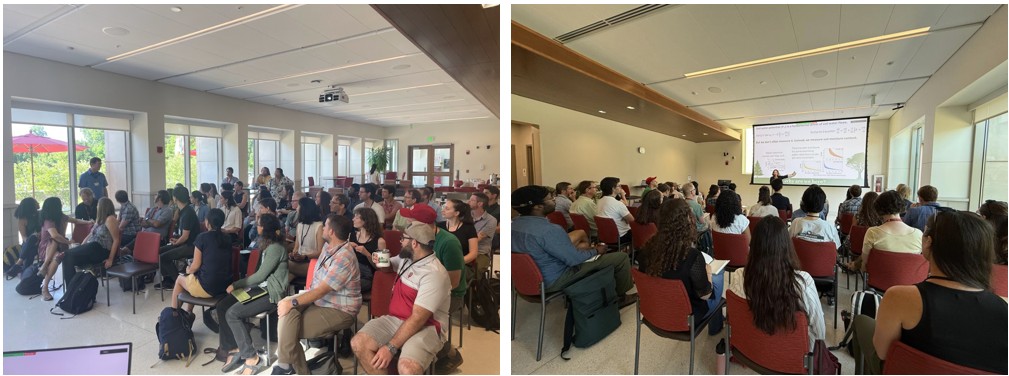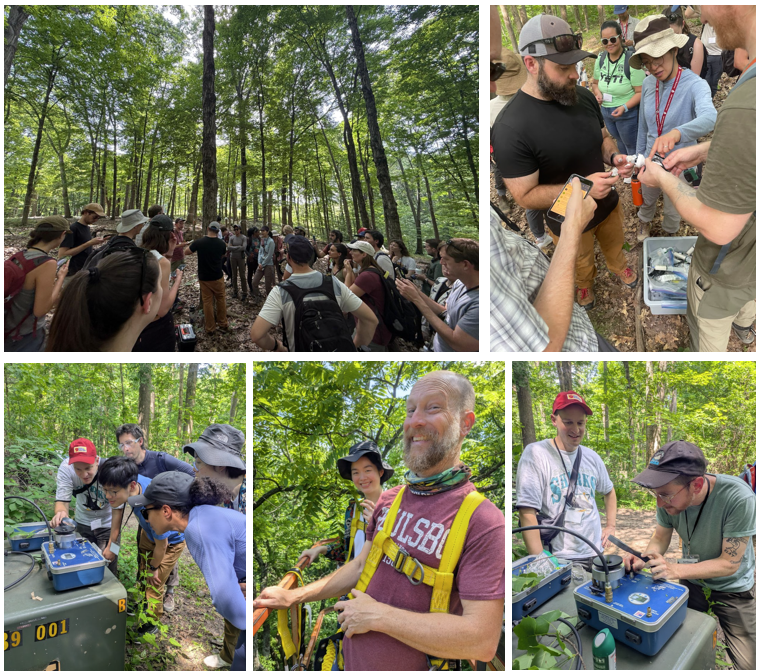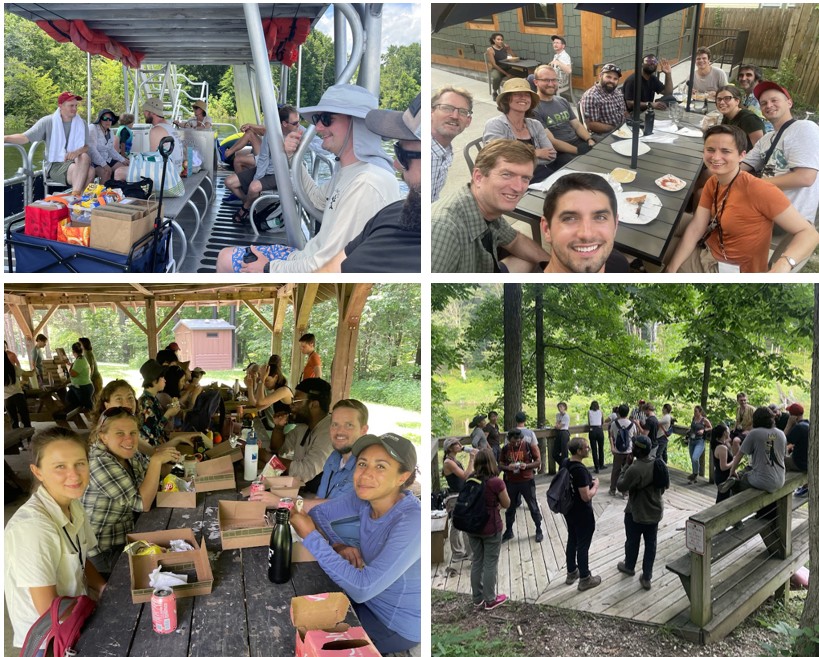Dates: June 23-27, 2025
Location: Indiana University - Bloomington, Bloomington, IN, USA
This week-long wokshop convened an international group of over fifty researchers representing a range of institutions and career stages, all engaged in advancing network-enabled science to improve mechanistic and predictive understanding of plant responses to drought. The workshop was primarily supported by the PSInet RCN grant, with one of its core objectives being to introduce the research community to the PSInet database and foster its effective adoption. Additional support from FLUXNET Cooperation Project and Indiana University enabled international participant and an expanded agenda, emphasizing the integration of data across a wide range of observational networks and databases.
Key objectives and activities of the workshop included:
1)Identifying tractable, near-term research questions that can be addressed using the PSInet database, particularly in combination with complementary networks such as FLUXNET, SAPFLUXNET, and the xylem functional traits (XF) database.
2) Exploring opportunities for collaborative publications and follow-up proposals aimed at advancing these research priorities.
3) Introducing the ecophysiological community to PSInet through hands-on tutorials, while also (re)familiarizing participants with related data platforms, including FLUXNET, SAPFLUXNET, XFT, and emerging tree dendrometer networks.
4) Designing a distributed graduate seminar that builds upon the ideas generated during the workshop and is scheduled to take place during the 2025–2026 academic year.
5)Outlining a long-term funding strategy to ensure the sustainability of PSInet and, potentially, support aspects of other network operations through an integrated “network-of-networks” initiative.
Overall description of the scientific discussion of the workshop:
The workshop was structured to offer a dynamic blend of plenary talks, database and network demonstrations, working and breakout group sessions, field measurements, and social activities to foster collaboration among participants.
From Monday through Wednesday, the schedule was centered around plenary sessions featuring leading scientists in the field of plant hydraulics. These talks covered a broad spectrum of topics, from field-based experiments and modeling approaches to remote sensing and the integration of a variety of measurement types. Dr. Kim Novick, the primary organizer of the workshop, opened the event with an overview of the goals and structure of the week. This was followed by invited keynote presentations, beginning with Dr. Richard Peters, who spoke on “Stem Shrinkage: The Invisible Pulse of Drought Stress.” Dr. Kiona Ogle followed with a talk titled “Plant and Ecosystem Fluxes: Timescales of Influence and Bidirectional Coupling,” highlighting interactions across temporal and spatial scales. Later in the week, Dr. Bill Hammond presented “Potential Catastrophe: Xylem Tension in the Anthropocene,” sharing insights from an ongoing project examining the decline in ecosystem health due to increasing environmental stressors. Dr. Yanlan Liu emphasized the importance of spatial scaling in her presentation on ecosystem-effective hydraulic traits across landscapes. On Wednesday, Dr. Julia Green introduced her newly funded project focused on “Using Soil Water Potential as a Predictor of Vegetation Water Stress.” The plenary series concluded with Dr. Andrew Feldman, who presented a proposed NASA dryland field campaign and the value of integrating field-scale microwave measurements to better capture vegetation water dynamics.
A key highlight of the workshop was the hands-on database and network demonstration, paired with breakout sessions aimed at identifying research questions that can be addressed using currently available data. Dr. Jessica Guo and Dr. Ana Maria Restrepo-Acevedo led the PSInet demonstration, guiding participants through the newly developed plant water potential database and instructing them on how to access and utilize the data. In support of the workshop’s broader goal of fostering cross-network integration, attendees were also introduced to several complementary networks. Dr. Bill Hammond presented on XFT, Dr. Rafael Poyatos on SAPFLUXNET, Dr. Kim Novick on FLUXNET, and Dr. Daniel Beverly and Alex Crookshanks introduced the new Regional Environmental Soil Hydraulics (ReESH) project. Participants engaged in interactive sessions that provided hands-on experience with data access, basic processing, and more advanced analytical techniques. These sessions also created space for direct discussion with network leads, enabling participants to troubleshoot questions, explore use cases, and form potential collaborations.
The breakout sessions during the workshop were structured to balance planned and participant-driven discussions. The steering committee organized and defined the topics for the first two days, while the remaining three days featured sessions proposed and requested by attendees. This approach encouraged broad participation and ensured that a wide range of interests and expertise were represented. The topics covered spanned multiple scales and levels of research. Sessions ranged from leaf-level optical vulnerability curve measurements to plant-level analyses using water potential data and dendrometers. Other discussions focused on observational patterns such as hysteresis, as well as plot-to landscape-scale integration of GNSS and VOD measurements. All breakout sessions were well attended, fostering dynamic exchanges and cross-disciplinary collaboration.
The plenary sessions, databases demo and breakout discussions were complemented by two hands-on field experiences, which provided participants with practical exposure to a range of plant water status measurement techniques. Attendees had the opportunity to work directly with instruments such as psychrometers, dendrometers, and FloraPulse sensors. One of the field activities included a visit to Morgan Monroe State Forest, where participants conducted field measurements in a natural setting, reinforcing workshop concepts through applied learning.
Social activities:
In addition to the rich scientific programming, the workshop featured a variety of social activities designed to foster connection, community, and collaboration among attendees. Events included group dinners, morning yoga sessions, a running club, climbing outings, sunset conversations by the lake, informal picnics, and a celebratory boat trip on Lake Monroe during the final afternoon. These moments offered valuable opportunities for informal dialogue and relationship-building beyond the academic setting.
We recognized that these social interactions play a critical role in strengthening professional networks and laying the groundwork for future collaborations. A central goal of the workshop was to cultivate a welcoming environment where participants from a wide range of backgrounds and career stages felt comfortable engaging in meaningful conversations. This workshop offered a rare opportunity to connect with leading scientists in the field of plant hydraulics in both structured and informal settings—creating space not only for the exchange of ideas but also for the formation of lasting professional relationships.
Future Steps Following the Workshop:
On the final day of the workshop, participants gathered to reflect on the week’s activities and discuss future directions for PSInet and the broader network community. Several concrete ideas and action items emerged from these conversations:
1) Distributed Graduate Seminar As outlined in the original PSInet proposal, one key next step is the development of a distributed graduate seminar. This course will bring together students from multiple institutions who will participate simultaneously, often receiving credit by enrolling in a small section facilitated by faculty at their home institution. This model enables students to learn from a global group of experts while still benefiting from in-person mentorship and discussion. The course will cover the theoretical foundations of water movement through soil and plants, linking these processes to plant growth and mortality. It will also provide hands-on training in the use of PSInet and related databases (e.g., SAPFLUXNET, FLUXNET, ReESH, XFT). The latter part of the course will focus on student-led research projects using data from these networks, including the development of mini-proposals, data analysis, presentation of results, and the preparation of a final paper. Attendees of the workshop expressed strong interest and enthusiasm for participating in or facilitating this seminar. There were also discussions about recording the sessions to make the content accessible to students at institutions not formally participating in the course. Ideally, the first offering of the distributed seminar will take place during the summer semester of 2026.
2) Formation of Working Groups: Several working groups were initiated during the breakout sessions, with participants organized around shared research questions, field protocols, and long-term goals for advancing the science of plant hydraulics. These groups have remained active via dedicated Slack channels, enabling continued collaboration beyond the workshop. One example is the Hysteresis Group, which is focused on defining testable research questions and hypotheses related to hysteresis patterns in plant water relations. Their aim is to incorporate this behavior into modeling frameworks using data from networks such as FLUXNET, SAPFLUXNET, and PSInet. Another active group is the VOD/GNSS Initiative, which is currently working on a short manuscript outlining key challenges in estimating vegetation’s water content from microwave measurements. Their discussions include significant uncertainties at GNSS sites, requirements for ground-truthing, and strategies for integrating field data to support and validate satellite-based estimates.
The Network-enabled Understanding of Plant Water Hydraulics in a Changing World workshop: successfully brought together an interdisciplinary community committed to advancing plant hydraulics research through collaborative, network-enabled science. The combination of plenary talks, hands-on fieldwork, data demonstrations, and dynamic breakout sessions fostered rich scientific exchange and laid the groundwork for ongoing collaboration. With new working groups formed, plans for a distributed graduate seminar underway, and strong interest in integrating data across networks, the workshop not only strengthened existing connections but also created new opportunities for innovation and impact in the field. The enthusiasm and engagement demonstrated by participants highlight a strong foundation for ongoing scientific exchange and network integration beyond the workshop itself.
Many thanks to the workshop organizing committee: Kim Novick, Jessica Guo, Alex Konings, Rafael Poyatos, Julia Green, Bill Hammond, Steve Kannenberg, Daniel Beverly, and Ana Maria Restrepo Acevedo.


